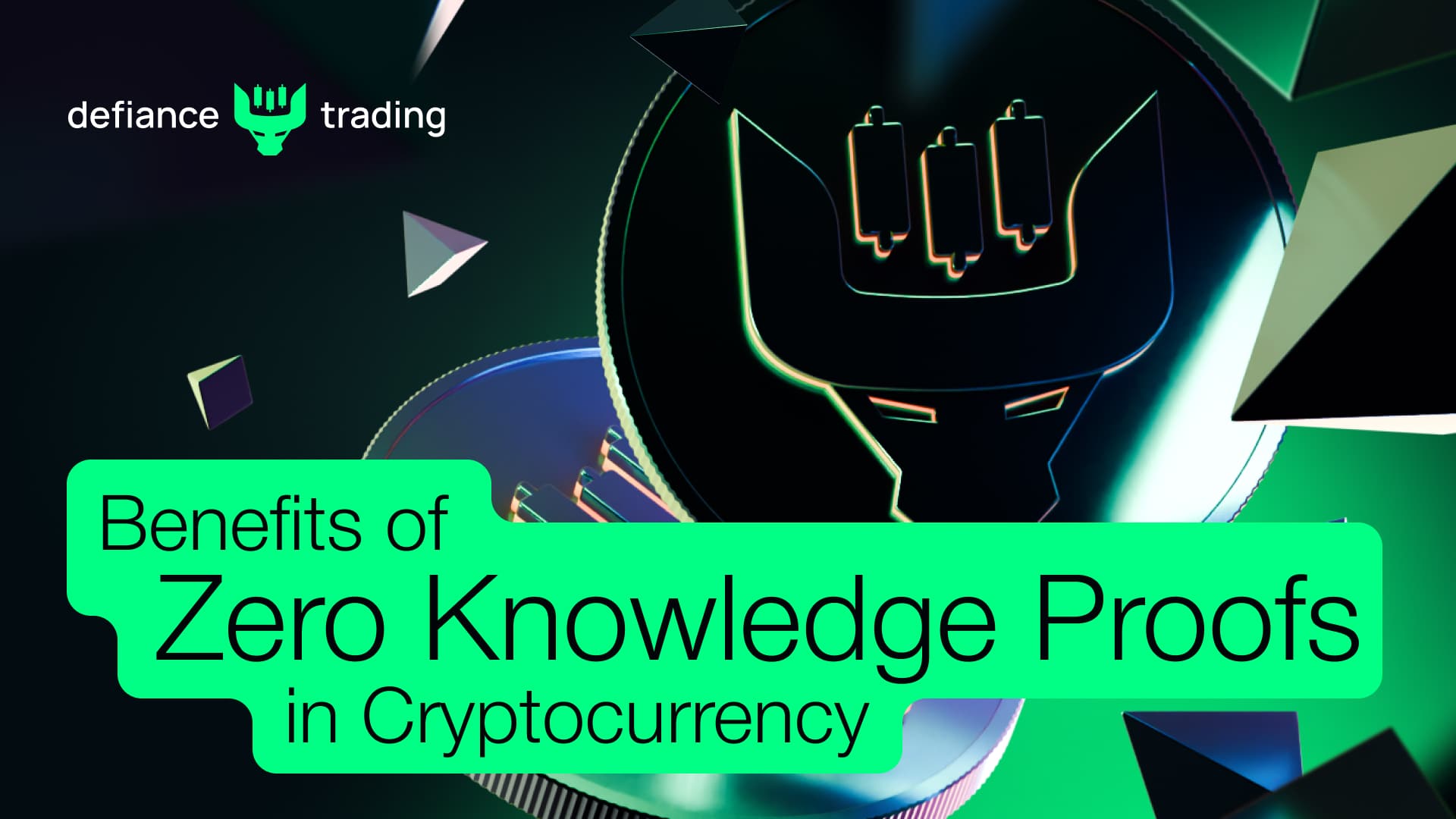Benefits of Zero Knowledge Proofs in Cryptocurrency

Think of a world where believing doesn’t depend on what you see. Zero knowledge proofs (ZKPs) are towing this path. The usual cryptocurrency setup has transaction details like addresses and transaction amounts visible to all. Even data analysts can download this information and use it without proprietary consent. This situation pictures transparency at its peak, but what happens to privacy?
Such sensitive data in the wrong hands can expose blockchain users to needless tracking and attack threats. While transparency is great, privacy remains invaluable. ZKPs patch this vulnerability by allowing permitted parties to check transaction legitimacy and yet not have the transaction contents. ZKPs ensure users can maintain privacy in their transactions and carry out other operations with confidence. These attributes encourage wider adoption of cryptocurrencies.
In this article, we will explore the meaning of zero knowledge proofs, how it came to be, the types of zero-knowledge proofs, its pillars, the benefits of ZKPs in cryptocurrency, and use cases.
Let us get started!
What is a Zero Knowledge Proof?
Zero knowledge Proof is a technique in cryptography that helps to prove validity without giving away any more information. This proving system involves two parties, a prover, and a verifier. They can publicly interact and share proof of ownership while preserving said details.
How can you convince me you know a secret without telling me the secret? That’s the place of ZKPs in cryptography, making it one of the most powerful tools ever.
Brief history of Zero Knowledge Proofs
ZKPs first appeared in a 1985 paper titled ‘The knowledge complexity of interactive proof systems’. The authors included a definition for ZKPs, which is still valid;
“A zero-knowledge protocol is a method by which one party (the prover) can prove to another party (the verifier) that something is true, without revealing any information apart from the fact that this specific statement is true.”
The initial idea was an interactive protocol where the prover and verifier communicate until the verifier is convinced. Although a marvelous discovery, ZKP was time and data-inefficient. Developers had to devise a non-interactive mode to scale zero-knowledge proofs.
By 1986, Fiat and Shamir invented the Fiat-Shamir technique. This method encodes an interactive ZKP into a digital signature. This discovery set the stage for wider ZKP adoption.
In 2011, ZKPs returned to the lips of crypto enthusiasts following a paper published at the International Symposium on Theory of Cryptography. This publication gave birth to SNARKS (Succinct Non-Interactive Arguments of Knowledge). Later, innovations like STARKs and Plonk will follow.
Types of Zero Knowledge Proofs
There are many variants of zero knowledge used to prove data authenticity but they are largely classified under;
ZK Snarks
Zero-Knowledge Succinct Non-interactive Arguments of Knowledge is one zero-knowledge proof that allows one party to claim possession of certain information without revealing it.
It involves using a secret phrase before the transaction proceeds. Although the computational background is complex, ZK snarks primarily demand the verifier to set up a hashed solution that the prover solves within a specific, satisfactory range.
ZK Starks
ZK Starks are similar to Snarks, but there is no need for a trusted setup. ZK Starks employs advanced methods like Merkle Trees for trust. More knowledge and computing power is necessary to supply the inverse function to a hash function.
Bulletproofs
Like Starks, Bulletproofs does not require trust. What is the difference? Bulletproofs make confidential transactions more efficient in size and aggregation. This method can shrink cryptographic proof by 10 times its initial size. Also, proving the validity of multiple values in a transaction adds nothing to the size of a single proof.
PLONK
PLONK (Permutations over Lagrange-bases for Oecumenical Non-interactive arguments of Knowledge) is an improvement on SNARKs efficiency. Plonk improves trust-based setup by increasing the number of programs you can prove with a single (this has a limit). A setup can include multiple parties, given that at least one participant is honest. Adding more participants does not compromise security.
Another edge is PLONK’s polynomial commitments for polynomial equations, which are flexible for different use cases and developer preferences.
Principles of Zero Knowledge Proofs
More is left to be seen about ZKPs, but every version is created with these principles in mind;
- Statistical soundness: If proof shows a false claim of ownership, the verifier can publicly refute such claims.
- Completeness: In another fashion, ZKPs allow a verifier to corroborate a proof that scores high on the probability of being correct.
- Zero-knowledge: This principle is the soul blood of ZKPs. It ensures that no information more than sufficient to prove ownership unravels.
Benefits of Zero Knowledge Proofs in Cryptocurrency
Here are ways ZKPs helps existing protocols in cryptocurrency improve;
- Private transactions
ZKPs allow minimal data exposure. This feature is a win for industries like finance, healthcare, and research and development because of the added consumer appeal. Organizations can assure users of data transparency while protecting its sensitive nature. - Increased security
ZKPs ensure you can verify transactions on the blockchain without knowing their details. For instance, you can provide evidence of funds to meet a college admissions requirement without disclosing your account balance. With this height of confidentiality, ZKPs helps to guard against unauthorized access and data breaches. - Highly scalable
ZKPs answer emerging issues like high computational load and demand for data storage. In ZKPs, the proof can replace the underlying data and reduce the space it takes up on the blockchain.
One way ZKPs can achieve scalability is through Merkle trees. This data structure summarizes loads of data into a single hash value. Since no two Merkle trees of the same size can have the same hash functions and root hash, each tree is unique. A Merkle Tree represents a transaction in a block without giving away other transactions. - Trust
With as few as two parties involved, ZKPs preserve data integrity. ZKPs rely on a system where data moves to the consumer directly, taking trust to a new level. They eliminate banks, payment processors, and other intermediaries susceptible to identity theft and data breaches. - Regulation compliance
Companies can leverage ZKPs to meet regulatory guidelines without divulging customer information. This advantage extends to Anti-Money Laundering checks and Know Your Customer processes.
ZKPs assist businesses in fulfilling GDPR (General Data Protection Regulation) and HIPAA (Health Insurance Portability and Accountability Act), which mandate minimum personal data collection for operations.
Use Cases of Zero Knowledge Proofs
Some areas integrating zero knowledge Proofs include;
Finance
Since digitalization hit the money scene, financial systems have become sitting ducks for attacks. Breaches have exposed billions of customer data, and renewing trust is climbing a steep hill for companies.
Among banks adopting ZKPs is Dutch Bank ING. It uses proof functions to process mortgage applications. This innovation encourages applicants to proceed with privacy preservation at its forefront.
Voting Systems
Election periods are times when people can exercise their franchise in a democratic society. However, democracy has failed in many regions due to a lack of transparency.
ZKPs use a smart contract with checks and balances to eliminate rigging. Voters can perform their civic obligation and remain anonymous. Observers can verify results on-chain. ZKPs preserve the purpose of democracy.
Incorporating ZKPs makes voting fast, cheap, and reliable. Estonia’s 2023 online elections showcase these benefits with over 50% of the voting done from home or work.
Internet of Things (IoT)
The Internet of Things refers to an increasing web of devices connected to the internet and has autonomy to take actions. An example is an alarm system that sends a signal to the nearest police station when it senses a break-in. Zero-Knowledge helps to secure these devices and protect user data stored within.
ZkPs can verify manufacturer updates to prevent malware attacks and allow only authorized software to load on gadgets. Because ZKPs enable reduced data transmission, IoT devices require less energy to function, and this advantage helps to beat down maintenance costs.
Conclusion
Thanks to ZKPs, transparency and privacy are finding a balance in the scales. One party can prove data ownership to another without spilling the tea. Verification is transparent and can reach levels that the verifier desires.
Although ZKP gathered momentum recently, the concept has existed since the 1980s. Over the years, it has undergone various modifications so entities can integrate as they see fit. Time will do wonders for ZKPs as more applications come to light.
ZKPs stand on three pillars: soundness, completeness, and zero-knowledge to present numerous benefits. These advantages include scalability, privacy, trust, and compliance with corporate regulatory bodies.
Today, we can point out ZKP applications in voting, finance, and decentralized infrastructure. Soon, more sectors will use ZKPs to secure data.
To get more information, visit our WEBSITE today!
Ready to Defy the Odds?
Become part of a growing movement
